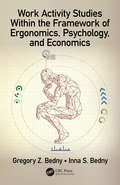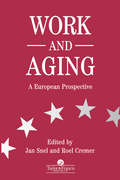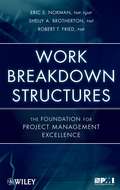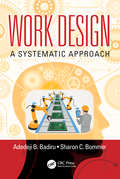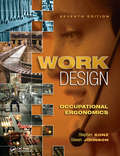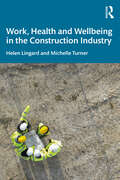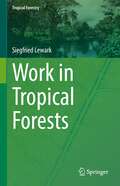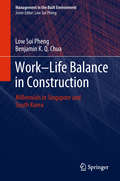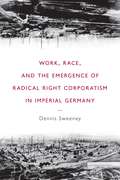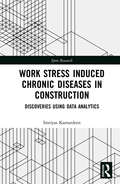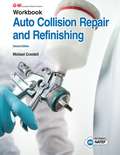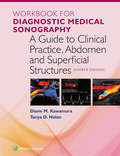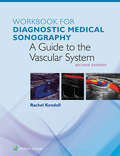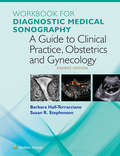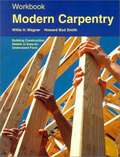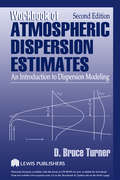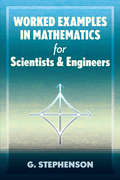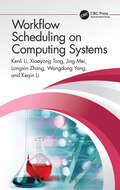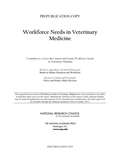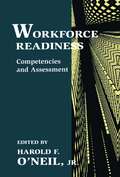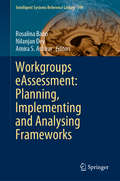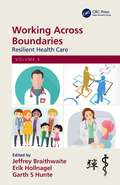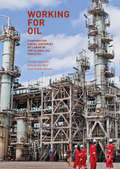- Table View
- List View
Work Activity Studies Within the Framework of Ergonomics, Psychology, and Economics (Human Activity)
by Gregory Z. Bedny Inna S. BednySystemic-structural activity theory (SSAT), founded by Gregory Bedny, is a relatively new unified framework for the study of efficiency of human performance, equipment, and software design. This book presents new recently obtained data in the field of SSAT that can be used in the study of efficiency and complexity of human performance. With increased cognitive demands to task performance, psychological methods of study of human activity play an important role. New principles and revised methods for the study of human work are supplemented by practical examples in manufacturing, construction industry, aviation, and human-computer interaction. Features: Presents new SSAT data Offers, for the first time, comparative analysis of studying efficiency and productivity from the perspective of ergonomics, psychology, and economics Includes examples of evaluation of economic efficiency of ergonomic innovations Provides advanced self-regulative models of activity and of all cognitive processes that describe strategies of task performance Introduces a new efficient method of morphological and analytical quantitative analysis Discusses new methods of evaluation of complexity and reliability of highly variable computerized and computer-based tasks Work Activity Studies Within the Framework of Ergonomics, Psychology, and Economics presents a comprehensive unified psychological theory that can be utilized as a general approach to the study of human activity not only for ergonomists and psychologists, but also for economists that study the efficiency of human performance.
Work and Aging: A European Prospective
by Jan SnelIn the past few years the topic of work and ageing has received much public and professional interest. The progressive "greying" of the population and its impact on work is a problem of widespread and growing concern, with major consequences for the economy in terms of productivity, performance, health care, work design and entry opportunities; and for the individual older worker. A European Symposium on Work and Ageing was held in Amsterdam in 1993. It was intended not only for a forum of scientists but also for practitioners and policy-makers who are actually involved in this growing field of social interest.; "Work and Aging", a multi-disciplinary book derives, in part, from this symposium, but also includes especially invited contribributions from experts in occupational health and safety, organizational psychology, cognitive science, and ergonomics.; Throughout the diverse chapters, incentives are suggested on how and why an organization could benefit from the asset of an ageing worker. Training programmes for human resource management, with respect to the elderly and disabled worker in particular, are offered in order to deal effectively with vocational rehabilitation.
Work Breakdown Structures
by Robert T. Fried Shelly A. Brotherton Eric S. NormanUnderstand and apply new concepts regarding Work Breakdown StructuresThe Work Breakdown Structure (WBS) has emerged as a foundational concept and tool in Project Management. It is an enabler that ensures clear definition and communication of project scope while performing a critical role as a monitoring and controlling tool. Created by the three experts who led the development of PMI's Practice Standard for Work Breakdown Structures, Second Edition, this much-needed text expands on what the standard covers and describes how to go about successfully implementing the WBS within the project life cycle, from initiation and planning through project closeout.Filling the gap in the literature on the WBS, Work Breakdown Structures: The Foundation for Project Management Excellence gives the reader an understanding of:The background and key concepts of the WBSWBS core characteristics, decomposition, representations, and toolsProject initiation and the WBS, including contracts, agreements, and Statements of Work (SOW)Deliverable-based and activity-based managementUsing the WBS as a basis for procurement and financial planningQuality, risk, resource, and communication planning with the WBSThe WBS in the executing, monitoring, and controlling phasesNew concepts regarding the representation of project and program scopeVerifying project closeout with the WBSUsing a real-life project as an example throughout the book, the authors show how the WBS first serves to document and collect information during the initiating and planning phases of a project. Then, during the executing phase, the authors demonstrate how the WBS transitions to an active role of project decision-support, serving as a reference and a source for control and measurement.
Work Design: A Systematic Approach (Systems Innovation Book Series)
by Adedeji B. Badiru Sharon C. BommerWork is all around us and permeates everything we do and everyday activities. Not all work is justified, not all work is properly designed, or evaluated accurately, or integrated. A systems model will make work more achievable through better management. Work is defined as a process of performing a defined task or activity, such as research, development, operations, maintenance, repair, assembly, production, and so on. Very little is written on how to design, evaluate, justify, and integrate work. Using a comprehensive systems approach, this book facilitates a better understanding of work for the purpose of making it more effective and rewarding.
Work Design: Occupational Ergonomics
by Stephan KonzThis book gives readers the tools they need to achieve work design that is ergonomically effective while remaining economically feasible. Whether studying work design/ergonomics in a college classroom, preparing for the Board of Certification in Professional Ergonomics (BCPE) exam, or working as a professional in the field, readers can depend on this book to provide them with the information they need. Work Design is a single source for ergonomics, work design, and work measurement. Its engineering orientation equips readers with practical design information and procedures; its explicit organization, conversational style, and clear explanations make it easy to read and understand. The book's many charts and graphics dynamically illustrate important concepts and principles, and its extensive references give readers confidence in the material.
Work Function and Band Alignment of Electrode Materials: The Art of Interface Potential for Electronic Devices, Solar Cells, and Batteries (NIMS Monographs)
by Michiko YoshitakeThis book covers a wide range of topics on work function and band alignment, from the basics to practical examples. Work function and band alignment determine electric properties at the interface including surfaces, such as electron emission, the Schottky barrier height, and ohmic contact. Basic physics is used to systematically explain how to adjust and measure work function and how to modify the band alignment required for controlling work function in functional materials and electrodes. Methods introduced in the book help to improve device performance and to solve the problems of controlling the voltage and efficiency of devices in a great variety of applications, including electronic devices, optical devices such as displays, and energy devices such as solar cells and batteries. Understanding the technical methods necessary for controlling work function and band alignment can help to solve problems such as non-ohmic contact at source–electrode or drain–electrode interfaces in metal–oxide–silicon structures, which directly contributes to improving power saving and reducing heat generation in computers.
Work, Health and Wellbeing in the Construction Industry
by Helen Lingard Michelle TurnerThis book covers a wide range of topics relating to the health and wellbeing of the construction workforce. Based on more than two decades of work examining various aspects of workers’ health and wellbeing, the book addresses a key topic in construction management: how the design of work environments, construction processes and organisation of work impact upon construction workers’ physical and psychological health. Occupational health is a significant problem for the construction industry. However, the subject of health does not receive as much attention in occupational health and safety research or practice as the subject of safety. Traditional management approaches (focused on the prevention of accidents and injuries) are arguably ill-suited to addressing issues of workers’ health and wellbeing. This book seeks to explain how workers' health and wellbeing are impacted by working in the construction industry, and suggest ways in which organisations (and decision makers within them) can positively shape workplaces and practices in ways that better support constructions workers to maintain healthy and productive working lives. Including chapter summaries and discussion questions to encourage student readers to reflect on and formulate their own viewpoints about the issues raised in each chapter, the book has the potential to be used as a textbook in undergraduate or postgraduate occupational health and safety, or construction management courses dealing with occupational health and safety. It could also be used as supplementary recommended reading in undergraduate or postgraduate programmes in architecture, engineering or management.
Work in Tropical Forests (Tropical Forestry)
by Siegfried LewarkThis book presents a synopsis, with an innovative approach, of abundance, types and conditions of work performed in the tropical plantation and natural forests. It covers work of formally and informally employed, and of own-account small-scale forest users, women and children. Activities in tree harvesting are analyzed, also on-site conversion by pitsawing, planting and pruning. The abilities of the workers and their efforts while fulfilling their tasks, resulting in performance and workload, are described with many examples of published studies. Influencing variables from organizational, technical and managerial sides are considered as much as included in the studies. The detailed descriptions demonstrate the methodical state of ergonomic research. For better understanding of the coverage the background of the development of forest work science is described. The lasting influence of Taylorism and the roles of ILO and FAO as well as NGOs, e.g. in certification, are pointed out.
Work-Life Balance in Construction: Millennials in Singapore and South Korea (Management in the Built Environment)
by Low Sui Pheng Benjamin K. ChuaThe book presents the latest studies on the work–life balance of millennial (also known as Generation Y) building professionals in Singapore and South Korea. Its main goal is to compare and contrast the workplace attitudes of millennials, and to provide guidelines that help supervisors in the construction industry manage their employees’ expectations regarding work–life balance. Accordingly, it explains and links various principles regarding work–life conflicts, work–life enrichments and the work–life interface. Furthermore, the book introduces readers to coping strategies, a dimension that has not yet been explored substantially and has the potential to contribute significantly to the study and understanding of work–life balance. The book makes recommendations for the top management on assigning a capable leader to drive the changes in the organization, and on empowering the leader to implement effective strategies for promoting work–life balance, especially for the millennials who are now playing an increasing central role in the global construction sector.
Work, Race, and the Emergence of Radical Right Corporatism in Imperial Germany
by Dennis SweeneyIn the late nineteenth and early twentieth centuries, the Saar river valley was one of the three most productive heavy industrial regions in Germany and one of the main reference points for national debates over the organization of work in large-scale industry. Among Germany's leading opponents of trade unions, Saar employers were revered for their system of factory organization, which was both authoritarian and paternalistic, stressing discipline and punitive measures and seeking to regulate behavior on and off the job. In its repressive and beneficent dimensions, the Saar system provided a model for state labor and welfare policy during much of the 1880s and 1890s. Dennis Sweeney examines the relationship between labor relations in heavy industry and public life in the Saar as a means of tracing some of the wider political-ideological changes of the era. Focusing on the changing discourses, representations, and institutions that gave shape and meaning to factory work and labor conflict in the Saar,Work, Race, and the Emergence of Radical Right Corporatism in Imperial Germanydemonstrates the ways in which Saar factory culture and labor relations were constituted in wider fields of public discourse and anchored in the institutions of the local-regional public sphere and the German state. Of particular importance is the gradual transition in the Saar from a paternalistic workplace to a corporatist factory regime, a change that brought with it an authoritarian vision that ultimately converged with core elements in the ideological discourses of the German radical Right, including the National Socialists. This volume will be of interest to scholars and students of labor, industrial organization, ideology and political culture, and the genealogies of Nazism. Dennis Sweeney is Associate Professor of History at the University of Alberta. "The author makes a very insightful argument about the emergence of a kind of scientific racism within the new corporatism, one that brings biopolitics into German industry prior to the rise of National Socialism. This book will be an important contribution to the history of Imperial Germany, and has much potential to appeal to audiences in other fields of history. " ---Andrew Zimmerman, George Washington University
Work-Related Musculoskeletal Disorders: A Review of the Evidence
by Steering Committee for the Workshop on Work-Related Musculoskeletal Injuries: The Research BaseA report on Work-Related Musculoskeletal Disorders
Work Stress Induced Chronic Diseases in Construction: Discoveries using data analytics (Spon Research)
by Imriyas KamardeenThis book aims to fill a gap in the current construction health and safety research and discover new knowledge about work stress induced chronic diseases among construction industry professionals. In achieving these aims, the book investigates: the nature and extent of psychosocial stressors experienced by construction professionals, stress management tactics applied and the impact on mental health the prevalence and occurrence patterns of serious chronic conditions such as insomnia, obesity, musculoskeletal disorders and vision impairment aetiological pathways from job stressors through chronic diseases to job performance. While there are many studies, policies and regulations aiming to look after the health of construction workers, little attention is paid to construction professionals. By applying advanced analytical methods to data collected in a national survey of construction professionals in Australia, the author presents new scientific evidence which can be used to help establish equitable workers' compensation treatments and outcomes for construction professionals in line with other professions. Moreover, the research and analysis are underpinned by theories and literature from public health and epidemiological disciplines in addition to literature from construction, and work health, safety and wellbeing domains. It is essential reading for any health policy makers and researchers in the fields of health and safety and construction management.
Workbook Auto Collision Repair and Refinishing
by Michael CrandellAuto Collision Repair and Refinishing details the latest collision repair and refinishing techniques. This comprehensive textbook presents both the theoretical and practical aspects of collision repair and refinishing in an easy-to-understand manner. It includes information on structural repair, nonstructural repair, mechanical and electrical repair, refinishing, and estimating. Auto Collision Repair and Refinishing is an indispensable resource for those preparing for a career in collision repair and refinishing, as well as experienced technicians preparing for the ASE collision repair and refinishing certification tests.
Workbook for Diagnostic Medical Sonography: Abdomen and Superficial Structures
by Diane KawamuraDesigned to accompany Diagnostic Medical Sonography: A Guide to Clinical Practice Abdomen and Superficial Structures, Fourth edition, this Workbook offers a full complement of self-study aids that actively engage students in learning and enable them to assess and build their knowledge as they advance through the text. Most importantly, it allows students to get the most out of their study time, with a variety of custom designed exercises to help them master each objective.
Workbook for Diagnostic Medical Sonography: A Guide To The Vascular System (Diagnostic Medical Sonography Series)
by Ann Marie KupinskiDesigned to accompany Diagnostic Medical Sonography: Vascular Imaging, this Workbook offers a full complement of self-study aids that actively engage students in learning and enable them to assess and build their knowledge as they advance through the text. Most importantly, it allows students to get the most out of their study time, with a variety of custom designed exercises to help them master each objective.
Workbook for Diagnostic Medical Sonography: A Guide to Clinical Practice Obstetrics and Gynecology (Diagnostic Medical Sonography Series)
by Susan Stephenson Julia Dmitrieva Barbara Hall-TerraccianoDesigned to accompany Diagnostic Medical Sonography: A Guide to Practice Obstetrics & Gynecology, Fourth edition, this Workbook offers a full complement of self-study aids that actively engage students in learning and enable them to assess and build their knowledge as they advance through the text. Most importantly, it allows students to get the most out of their study time, with a variety of custom designed exercises to help them master each objective.
Workbook for Modern Carpentry: Building Construction Details in Easy-to-Understand Form
by Howard Bud Smith Willis H. WagnerModern Carpentry is a colorful, easy-to-understand source of authoritative and up-to-date information on building materials and construction methods. The text provides detailed coverage of all aspects of light frame construction, including site preparation and layout; foundations; framing; sheathing; roofing; windows and doors; exterior finish; and interior wall, floor, and ceiling finish. Special emphasis is placed on the use of modern tools, materials, and prefabricated components in the application of interior trim, and the construction of stairs and cabinetwork.
Workbook of Atmospheric Dispersion Estimates: An Introduction to Dispersion Modeling, Second Edition
by D. Bruce TurnerThis completely updated and revised Second Edition of the popular Workbook of Atmospheric Dispersion Estimates provides an important foundation for understanding dispersion modeling as it is being practiced today. The book and accompanying diskette will help you determine the impacts of various sources of air pollution, including the effects of wind and turbulence, plume rise, and Gaussian dispersion and its limitations. Information is shown in summary graphs as well as in equations. The programs included on the diskette allow you to "get the feel" for the results you'll obtain through the input of various combinations of parameter values. The sensitivity of data to various parameters can be easily explored by changing one value and seeing the effect on the results. The book presents 37 example problems with solutions to show the estimation of atmospheric pollutant concentrations for many situations.
Worked Examples in Mathematics for Scientists and Engineers (Dover Books on Mathematics)
by G. StephensonThis rich collection of fully worked problems in many areas of mathematics covers all the important subjects students are likely to encounter in their courses, from introductory to final-year undergraduate classes. Because lecture courses tend to focus on theory rather than examples, these exercises offer a valuable complement to classroom teachings, promoting the understanding of mathematical techniques and helping students prepare for exams. They will prove useful to undergraduates in mathematics; students in engineering, physics, and chemistry; and postgraduate scientists looking for a way to refresh their skills in specific topics.The problems can supplement lecture notes and any conventional text. Starting with functions, inequalities, limits, differentiation, and integration, topics encompass integral inequalities, power series and convergence, complex variables, hyperbolic function, vector and matrix algebra, Laplace transforms, Fourier series, vector calculus, and many other subjects.
Workflow Scheduling on Computing Systems
by Kenli Li Keqin Li Xiaoyong Tang Jing Mei Longxin Zhang Wangdong YangThis book will serve as a guide in understanding workflow scheduling techniques on computing systems such as Cluster, Supercomputers, Grid computing, Cloud computing, Edge computing, Fog computing, and the practical realization of such methods. It offers a whole new perspective and holistic approach in understanding computing systems’ workflow scheduling. Expressing and exposing approaches for various process-centric cloud-based applications give a full coverage of most systems’ energy consumption, reliability, resource utilization, cost, and application stochastic computation. By combining theory with application and connecting mathematical concepts and models with their resource management targets, this book will be equally accessible to readers with both Computer Science and Engineering backgrounds.It will be of great interest to students and professionals alike in the field of computing system design, management, and application. This book will also be beneficial to the general audience and technology enthusiasts who want to expand their knowledge on computer structure.
Workforce Needs in Veterinary Medicine
by Policy and Global Affairs Committee to Assess the Current and Future Workforce Needs in Veterinary Medicine Board on Agriculture and Natural Resources Board on Higher Education and Workforce Division on Earth and Life StudiesThe U.S. veterinary medical profession contributes to society in diverse ways, from developing drugs and protecting the food supply to treating companion animals and investigating animal diseases in the wild. In a study of the issues related to the veterinary medical workforce, including demographics, workforce supply, trends affecting job availability, and capacity of the educational system to fill future demands, a National Research Council committee found that the profession faces important challenges in maintaining the economic sustainability of veterinary practice and education, building its scholarly foundations, and evolving veterinary service to meet changing societal needs. Many concerns about the profession came into focus following the outbreak of West Nile fever in 1999, and the subsequent outbreaks of SARS, monkeypox, bovine spongiform encephalopathy, highly pathogenic avian influenza, H1N1 influenza, and a variety of food safety and environmental issues heightened public concerns. They also raised further questions about the directions of veterinary medicine and the capacity of public health service the profession provides both in the United States and abroad. To address some of the problems facing the veterinary profession, greater public and private support for education and research in veterinary medicine is needed. The public, policymakers, and even medical professionals are frequently unaware of how veterinary medicine fundamentally supports both animal and human health and well-being. This report seeks to broaden the public's understanding and attempts to anticipate some of the needs and measures that are essential for the profession to fulfill given its changing roles in the 21st century.
Workforce Readiness: Competencies and Assessment
by Harold F. O'NeilCurrent economic difficulties and the challenge of competing in the world market have necessitated a rethinking of American approaches to the utilization of people in organizations. Management now recognizes a need to have workers take on more responsibility at the points of production, of sale, and of service rendered if the United States is to compete in rapidly changing world markets. This development means that much more is expected of even entry-level members of the American workforce. Thus, even more is expected of our high schools and colleges to provide this type of workforce. The need of American management for workers with greater skills and who can take on greater responsibility has spawned many commissions, task forces, and studies. All of them have contributed to the vast evidence documenting the need for a more highly skilled workforce. These studies are summarized and synthesized in this book. However, what remains largely undone is the development of methods to assess the necessary skills that have been identified. A major portion of this book deals with assessment issues. Workforce Readiness: Competencies and Assessment explores the state-of-the-art in the specification of competencies (skills) and their assessment for students entering the world of work from both high school and college. Both individual and team competencies are examined via data that has been reported and collected in various settings--schools, laboratories, and industrial facilities.
Workgroups eAssessment: Planning, Implementing and Analysing Frameworks (Intelligent Systems Reference Library #199)
by Rosalina Babo Nilanjan Dey Amira S. AshourThis book was developed during a particular pandemic situation in the whole world which confined people to their homes. Therefore, there was a rise in the use of distance working and learning (e-learning) which led to a very quick adoption of technology in order to guarantee different approaches to fulfil the same or better outcomes and ensure that people are connected. This book provides a better understanding about the importance of teams' assessment and collaborative work, as well as the use of collaboration tools and online assessment techniques supported by technology. Consequently, the book is aimed at all institutions that seek new working environments, namely higher education institutions, companies and organizations, sports teams, and others. Furthermore, this book provides new approaches and systems to carry the knowledge and learning assessment. The book gathers knowledge from several authors, related to collaboration environments and tools, as well as their insights on how technology can be applied to carry assessment processes. The book seeks to provide knowledge on new technologies and different learning environments.
Working Across Boundaries: Resilient Health Care, Volume 5
by Jeffrey Braithwaite Erik Hollnagel Garth S HunteThe book demonstrates how Resilient Health Care principles can enable those on the frontline to work more effectively towards interdisciplinary care by gaining a deeper understanding of the boundaries that exist in everyday clinical settings. This is done by presenting a set of case studies, theoretical chapters and applications that relate experiences, bring forth ideas and illustrate practical solutions. The chapters address many different issues such as resolving conflict, overcoming barriers to patient-flow management, and building connections through negotiation. They represent a range of approaches, rather than a single way of solving the practical problems, and have been written to serve both a scientific and an andragogical purpose. Working Across Boundaries is primarily aimed at people who are directly involved in the running and improvement of health care systems, providing them with practical guidance. It will also be of direct interest to health care professionals in clinical and managerial positions as well as researchers. Presents the latest work of the lauded Resilient Health Care Net group, developing applications of Resilience Engineering to health care, furthering safety thinking and generating applicable solutions that will benefit patient safety worldwide Enables health care professionals to become aware of the boundaries that affect their work so that they are able to use their strengths and overcome their weaknesses Written from a Safety-II perspective, where the purpose is to make sure that as much as possible goes well and the focus therefore is on everyday work rather than on failures. There are at present no other books that adopt this perspective nor which go into the practical details Provides a concise presentation of the state of resilient health care as a science, in terms of major theoretical issues and practical methods and techniques on the overarching and important topics of boundary-crossing and integration of care settings
Working for Oil
by Touraj Atabaki Elisabetta Bini Kaveh EhsaniThis volume examines the social history of oil workers and investigates how labor relations have shaped the global oil industry during the twentieth century and today. It brings together the work of scholars from a range of disciplines, approaching the social, political, economic and cultural dimensions of oil. The contributors analyze a number of key oil producing regions, including the Americas, the Middle East, Central Asia, the Caucasus, Europe and Africa.
